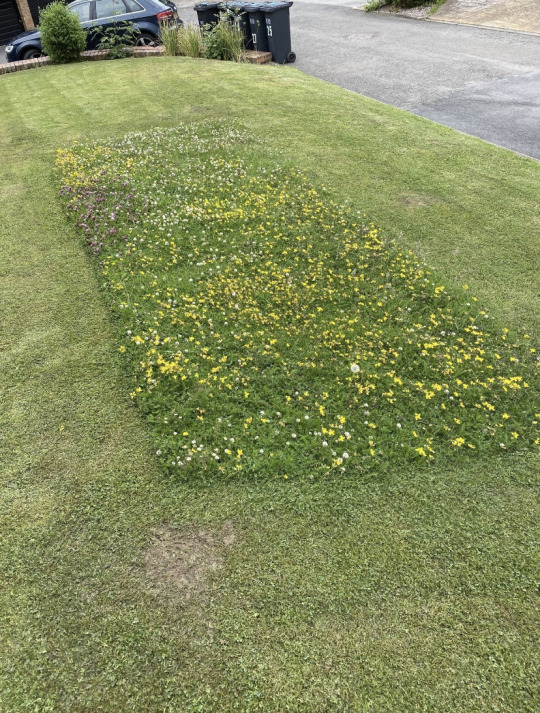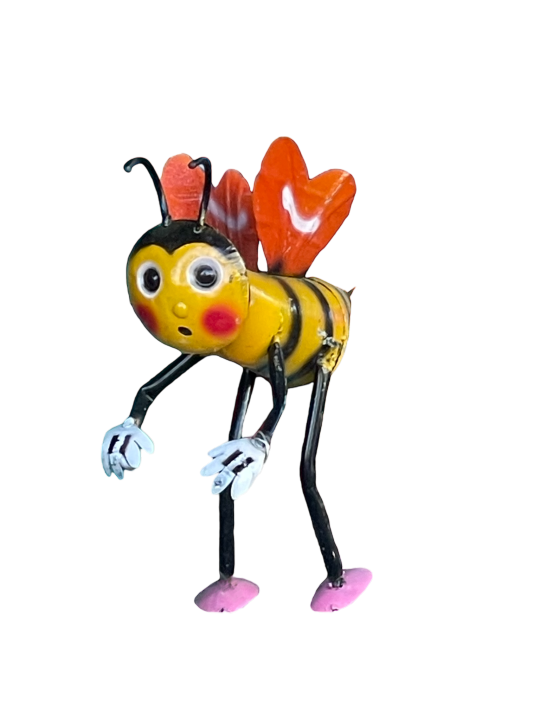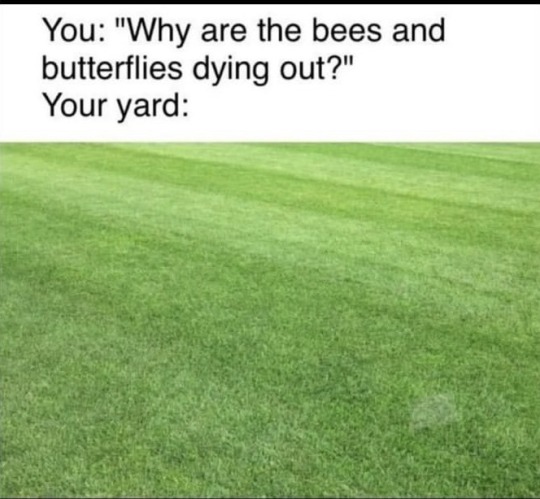#bee lawn
Text
No Mow May-Planting a Pollinator Friendly Lawn
Turf grass lawns are an American tradition. Everyone who has any kind of yard or property aspires to having a perfect green manicured carpet. But as we now know, grass can be a dead zone for native insects and birds, devoid of any nutrition or habitat for native species. Mowing, watering, fertilizing, and pest controls applied to turf, all impact the environment negatively and can be…

View On WordPress
#bee lawn#eco-friendly lawn#Flawn#flowering lawn#lawn substitutes#native lawn#no mow May#pollinator lawn
1 note
·
View note
Text
How people in the USA loved nature and knew the ways of the plants in the past vs. nowadays
I have been in the stacks at the library, reading a lot of magazine and journal articles, selecting those that are from over fifty years ago.
I do this because I want to see how people thought and the tools they had to come up with their ideas, and see if I can get perspective on the thoughts and ideas of nowadays
I've been looking at the journals and magazines about nature, gardening, plants, and wildlife, focusing on those from 1950-1970 or thereabouts. These are some unstructured observations.
The discourse about spraying poisons on everything in your garden/lawn has been virtually unchanged for the past 70 years; the main thing that's changed is the specific chemicals used, which in the past were chemicals now known to be horribly dangerous and toxic. In many cases, just as today, the people who opposed the poisons were considered as whackos overreacting to something mostly safe with a few risks that could be easily minimized. In short, history is not on the pesticides' side.
Compared with 50-70 years ago, today the "wilderness" areas of the USA are doing much better nowadays, but it actually appears that the areas with lots of human habitation are doing much worse nowadays.
I am especially stricken by references to wildflowers. There has definitely been a MASSIVE disappearance of flowers in the Eastern United States. I can tell this because of what flowers the old magazines reference as common or familiar wildflowers. Many of them are flowers that seem rare to me, which I have only seen in designated preserves.
There are a lot more lepidopterans (butterflies and moths) presumed to be familiar to the reader. And birds.
Yes, land ownership in the USA originated with colonization, but it appears that the preoccupation with who owns every little piece of land on a very nitpicking level has emerged more recently? In the magazines there is a sense of natural places as an unacknowledged commons. It is assumed that a person has access to "The creek," "The woods," "The field," "The pond" for simple rambling or enjoyment without personally owning property or directly asking permission to go onto another person's property.
There is very little talk of hiking and backpacking. I don't think I saw anything in the magazines about hiking or going on hikes, which is strange because nowadays hiking is the main outdoor activity people think of. Nature lovers 50-70 years ago described many more activities that were not very physically active, simply watching the birds or tending to one's garden or going on a nice walk. I feel this HAS to do with the immediately above point.
Gardening seems like it was more common, like in general. The discussion is about gardening without poisons or unsustainable practices, instead of trying to convince people to garden at all.
Overall, the range of animals and plants culturally considered to be common or familiar "backyard" creatures has narrowed significantly, even as the overall conservation status of animals and plants has improved.
This, to me, suggests two things that each may be possible: first, that the soils and environments of our suburbs and houses have sustained such a high level of cumulative damage that the life forms they once supported are no longer able to live, or second, that our way of managing our yards and inhabited areas has become steadily more destructive. Perhaps it may be the case that the minimum "acceptable" standard of lawn management has become more fastidious.
In conclusion, I feel that our relationship with nature has become more distant, even as the number of people who abstractly support the preservation of "wilderness" has increased. In the past, these wilderness preservation initiatives were a harder sell, but somehow, more people were in more direct contact with the more mundane parts of nature like flowers and birds, and had a personal relationship with those things.
And somehow, even with all the DDT and arsenic, the everyday outdoor spaces surrounding people's homes were not as broadly hostile to life even though the people might have FELT more hostile towards life. In 1960, a person hates woodpeckers, snakes and moths and his yard is constantly plagued by them: in 2024, a person enjoys the concept of woodpeckers, snakes and moths but rarely sees them, and is more likely to think of parks and preserves as the place they live and need to be protected. Large animals are mostly doing better in 2024, but the littlest ones, the wildflowers and bugs and birds, have declined steeply. It's not because "wilderness" is less; it seems more because non-wilderness has declined in quality.
2K notes
·
View notes
Text

🪻🌱🐝 💜 🌿 ✨ // violets & violet miner bees // part of my natives + pollinators series // gouache on paper
tiny violet miner bees (Andrena violae) are a specific pollinator: they pollinate wood & dog violets in the Northeast, and show a strong preference for blue violets. letting your grassy yard rewild itself and grow violets every spring not only lets you make violet syrup, it also gives violet miner bees their most important food source and increases local pollinator diversity.
#my art#gouache#illustration#painting#art#cottagecore#artists on tumblr#botanical#spring#violet#pollinator#pollinators#native wildflowers#native plants#eco lawn#botanical illustration#violet miner bee#bees#cw: insects#insects
821 notes
·
View notes
Link
“Whatever it was, their neighbor’s mounting resentment burst to the fore in the fall of 2017, in the form of a letter from a lawyer for their homeowner association that ordered the Crouches to rip out their native plant beds, and replace them with grass.
The couple were stunned. They’d lived on their quiet cul-de-sac harmoniously with their neighbors for years, and chose native plants to help insects, birds and wildlife thrive. Now the association was telling them that their plantings not only violated the bylaws, but were eyesores that hurt property values. “Your yard is not the place for such a habitat,” the letter read.
The Crouches were given 10 days to convert their front yard into a lawn that looked like everyone else’s. But instead of doing what they were told, the couple fought back, and ended up paving the way for a groundbreaking state law.“
5K notes
·
View notes
Text
HYMENOPTERA GROUP CHAT
🐜 bugs life radicalized me
Tending to my fungal garden
🍄 2 ☘️ 3
🐝 beesknees
frolicked amongst some flowers today ^-^
👍 5 🌸 5
⚠️ wasp emoji when
Drank some delectable nectar !!
🤤 1 😍 1 🥰 1
🌻 bumbly creature
Ouuugh . I’m so yellow and roumd
🌝 20
🧍♂️Pesticide Steve
Making my lawn perfectly smooth and uniform with no flowers or crevices as we speak.
💀 10 🤨 15 🖕10000
#unreality#hymenoptera#ants#bees#wasps#bumblebees#I hate smooth lawns!!!! I hate smooth lawns!!!!!!!!!!
519 notes
·
View notes
Text

February 1st, 2024, and the Crocus are already up. I might be seeing bees starting to dig out of their natal chambers too. Won't be sure for a few more days.
It's not a bad thing if they are reading the weather right and the world is in sync with itself. It's not a good thing if they aren't.
.
53 notes
·
View notes
Text

#memes#meme#throwback#lol#funny#lol memes#funny memes#funny meme haha#funny stuff#save the bees#bees#hummingbird#plants#lawn care#lawngoals#not because im lazy#for the pollinators
50 notes
·
View notes
Text

Large mammals such as elephants, whales, and tigers tend to get a disproportionate amount of attention when it comes to conservation. Birds and beneficial insects are often overlooked.
Northern Ontario residents are building bee hotels to attract them and to encourage them to produce more bees.
Bee my guest: Northerners build hotels for pollinators as spring unfolds
Lawns are one of the worst things for pollinators and birds. They encourage wasteful water practices and unnecessary chemical use.
Michael Pollan put it best...
"A lawn is nature under totalitarian rule."
It's time to help our airborne friends and overthrow the tyranny of lawns.
youtube
Natural looking green space may require a bit more effort at the start of the growing season but is a lot less work from week to week. It's worth it just to get rid of the noise pollution and fumes from lawn mowers.
Get your local municipal governments interested in supporting nature-friendly and climate-friendly landscaping practices.
#birds#bees#nature#bee hotels#north ontario#herbicides#pesticides#lawns#conservation#water use#nature under totalitarian rule#michael pollan#kill your lawn#monte wolverton
102 notes
·
View notes
Text

Someone mowed their lawn but left a rectangle of wild flowers so the bees can use them.
#interesting#interesting facts#nature is everything#nature is weird#nature#discover#thats interesting#thats insane#thats incredible#bees#bee#insects#pollen#flowers#mowing#mow#lawn#humans#humans are nice#humans are cool#thats cool#awww#aww#awww this is so cute#wholesome#awwww#awwwww#awwww cute#aww <3#thats crazy
32 notes
·
View notes
Text

#bees#bee#png#random pngs#transparent png#transparent background#random#transparent#pngs#weird png#cute pngs#metal#sculpture#lawn ornaments
23 notes
·
View notes
Text

Based biofriendly lawn enthusiast vs. beta cuck HOA
#HOAs are evil and honestly they serve no purpose other to reinforce early 1900s redlining policies#fuck hoas#wildlife#natural lawns#front yard#wildflowers#plants#flowers#spring#garden#neighborhood#lawns#i got a picture of general wildflowers in a lawn off google if these are not actually ideal biofriendly plants/flowers im sorry#fuck Bermuda grass#let the insects have homes#bees#save the bees#ecofriendly#pollinators#gardening#pollination
8 notes
·
View notes
Text


Treehouse Gardens
#elfin thyme#thyme#pink flowers#bee#honeybee#plant blog#plant photography#plants#neighborhoodsightseeing#flowers#garden#plant#nature#thyme lawn#flower photography#original photography
21 notes
·
View notes
Text
Listening to Nature's Best Hope by Douglas W. Tallamy and I feel really inspired. In this book, as well as in Braiding Sweetgrass written by Robin Wall Kimmerer, there is an important emphasis on healing the human relationship with nature.
A vast majority of humans have this idea that humans live here and nature is out there, which brings about a lack of compassion and understanding of the animals and plants that exist in the spaces that we occupy, as well. When humans think of natural spaces that are "worthy" of stewardship, they often think of national parks or forests, the There, and not about the songbirds in the trees outside their home or the insects in the grass of their yard or even the grass itself.
Nature is here. It is everywhere, or at least it should be. Humans benefit directly from the same ecosystems as other animals and when we buzzcut the already non-native grass into a short lawn because HOH said so, we rob ourselves of pollinators that will help healthy plants reproduce. We rob ourselves of healthy plants and the air quality diminishes. Erosion/flooding occurs more frequently. If we keep native plants planted in our yards, we attract native species that continue to keep the land healthy.
We humans need to learn to live together with nature, not apart from it. The idea that we aren't natural beings doesn't help, either. There are many groups of people that still follow the patterns of nature to survive. The flocks of birds, the movement of deer or elk herds, the blossoming and fruit-bearing of local tree species are not a forgotten knowledge. And I don't say this to sound like a hippie. What I mean to say is humans are natural and belong in nature just as much as any other species.
Creating biological corridors in our yards, our corporate spaces, and our cities is an important and necessary act of land stewardship and conservation. Plant native flora if you can. Get with your local conservation group and find out what species in your area are threatened and see what you can do to help, if anything. Volunteer to pick up trash or plant trees.
We can help. Don't give up.
#wildlife#conservation#nature#animal#animals#plants#flora#fauna#academia#ecology#native plants#invasive species#mother earth#pollinators#butterflies#wasps#bees#lawns#no lawns
7 notes
·
View notes
Text

Message brought to you by Bee Friendly Gardening
2K notes
·
View notes
Text

272 notes
·
View notes
Text
i love you dandelions 🌼💛🌼💛🌼
#deserves it's own post#I LOVE YOU DANDELIONS#i hate you 16th century royal/noble lawn care standards intended to flaunt wealth that somehow became universal and persist into modern day#this has been a shitpost#save the bees etc but also its just such a happy nostalgic flower i dont get hating it in the first place#literally couldn't be me
21 notes
·
View notes